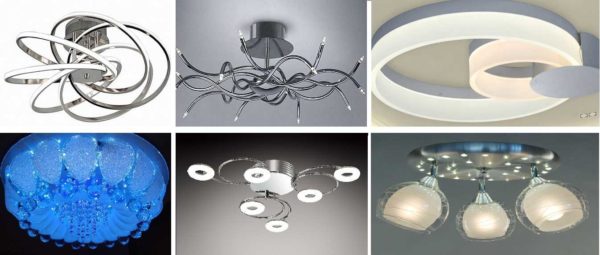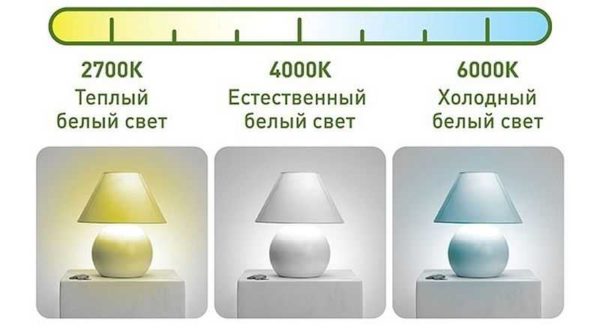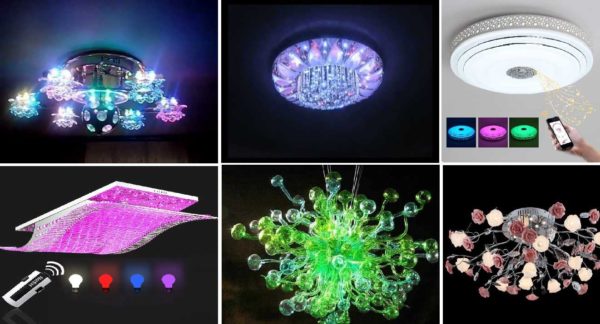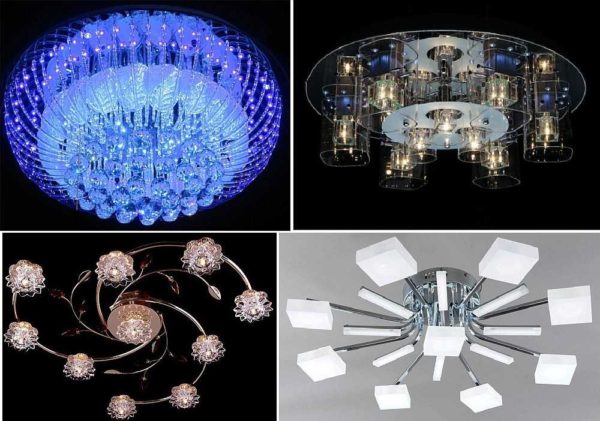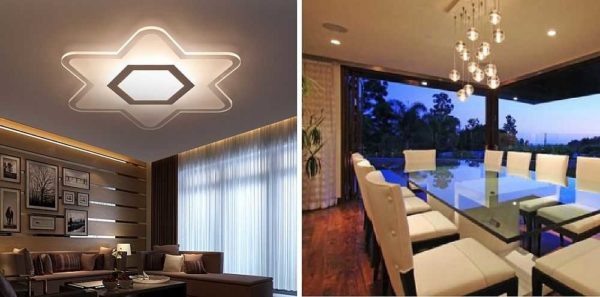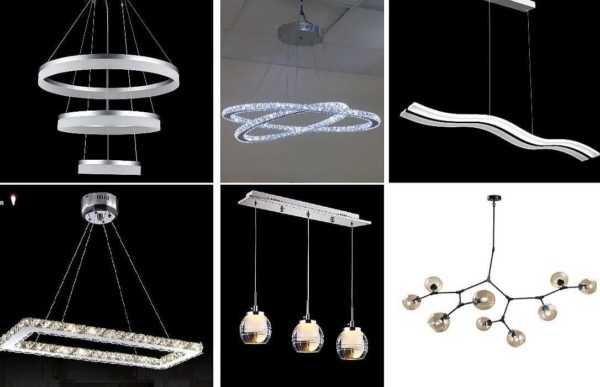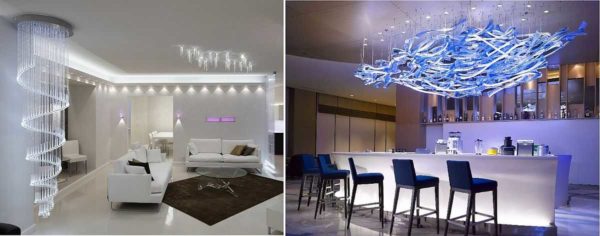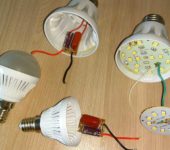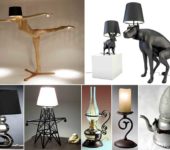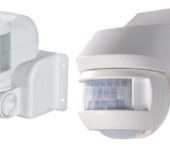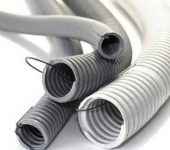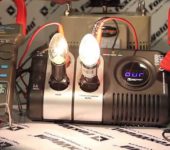How to choose a chandelier with LEDs
With the development of technologies, we have more and more new interesting devices and devices, and old and familiar ones acquire new functions and capabilities. For example, it has become fashionable to buy LED lighting fixtures. There are two significant reasons for this - their varied design and economy. About what properties LED chandeliers have for home, how to choose them and let's talk further.
The content of the article
Features of LED chandeliers
All the characteristics, advantages and disadvantages of this type of lighting fixtures are associated with the fact that they use LEDs as light sources. It is they who determine their properties and capabilities.
Diverse design
An LED, even a powerful enough one, is a small crystal, several millimeters in size, and it can produce a powerful luminous flux. Some crystals of 3 * 3 mm in size can replace a not very powerful incandescent lamp. Another thing is that such crystals are expensive. But they, subject to the operating conditions, can work for decades.
These properties - significant luminous flux at a small size - expand the design possibilities to infinity. When developing the design of all other lamps, designers have to come up with some kind of shades, and rather large ones, so that the light source can be hidden.
When working with LEDs, designers have practically no restrictions - millimeter light sources can be placed in any order, quantity. "Plafond" is not required for them, since they have different scattering angles. Even if you make a shade, the approach is mainly aesthetic, technical requirements are minimal. In this regard, the stylistic performance is very different - from the usual classics to the advanced high-tech, minimalism, loft. You can find any styles.
Adjustment options: brightness and glow temperature
Most of the lighting lamps can only emit light of a certain spectrum (color). Incandescent and halogen lamps give only white light, some other colors can only give out fluorescent ones, and even then not too much.
LEDs are designed in such a way that they can produce light of any color. This property is used in LED chandeliers with a control panel. They use three crystals as a light source at once - red, green and blue. By changing the brightness of the glow of each of the bottom we get any color of the spectrum. That is, an LED chandelier for a home can glow not only with white light (with different shades), but also with blue, green, red, etc. Please note that not all models have this feature, but only some.
They have LED chandeliers for home and one more feature - the brightness of the glow can be adjusted within wide limits. This opportunity is realized on the basis of incandescent lamps, for which special devices are used - dimmers. They lower / increase the voltage, which determines the level of glow of the lamps. To change the brightness of the light using a dimmer, you need to go to it (usually built into the switch) and turn the handle. Even this "focus" does not work with fluorescent or halogen lamps, they cannot work at reduced voltage.
LEDs change the glow level in a wide range and this function can be realized remotely - from the control panel. You can change the amount of light for both white and colored crystals. This function can be very convenient in nurseries and bedrooms - you don't have to turn off the light, but only dim it to acceptable values.
Power supply parameters and service life
LEDs operate from a constant voltage of 12 V, while in the network we have variable 220 V. For direct connection to a household network, a voltage converter is built into lighting devices of this type, which rectifies and lowers the voltage to the required values. The life of the LEDs depends on the quality of this converter - the more stable the power supply, the longer the LEDs will last.
In general, LEDs can work without significant changes in characteristics for 30-50 thousand hours. This is equivalent to 20-50 years of work. But this is only if the voltage is applied within the specified limits.
Unfortunately, food in our networks is far from stable. There are sharp jumps both up and down. Such surges have a negative effect on the service life of LEDs - they burn out and lose brightness. Since an LED chandelier is far from cheap, it makes sense to supply power through a stabilizer. This, of course, is an additional expense, but the stabilizer, by creating normal conditions for the LEDs, will significantly extend their service life.
Energy savings and low heat generation
LED lighting devices are characterized by increased efficiency - a lamp that consumes 15-20 W of electricity, the same amount of light is emitted as a 100 W incandescent lamp. This is due to the fact that the LED most of the energy consumed is spent on glowing and only a small part of it is converted into heat. At the moment, these are the most energy efficient light sources.
The small amount of heat emitted by LED chandeliers for home allows them to be used for stretch ceilings.
LED chandeliers for home: a choice
When choosing an LED chandelier for your home, in addition to aesthetic criteria and dimensions, you need to keep track of some more technical points:
- Supply voltage. Most household LED chandeliers are connected directly to a 220 V. But there are models that must be connected through converters to a reduced constant voltage - 12 V or 24 V. In the technical specifications, this parameter must be indicated.
- Illuminated area. We can use an ordinary chandelier with standard sockets to illuminate rooms of different sizes - you can supply lamps of different wattage. This does not work with LED chandeliers: LEDs are sealed inside and have certain parameters. Therefore, when choosing, pay attention to what maximum area this particular lighting device can illuminate. It is desirable that your room is no larger.
- Colour temperature. This parameter is important for LED chandeliers without a remote control. LEDs can produce white light of different "temperatures" - warm, like an incandescent lamp, cold, like a fluorescent lamp. You need to decide which one you want and look for lamps with suitable parameters.
- Enclosure protection degree. For residential premises, as well as for technical ones with normal operating conditions, you can ignore the degree of protection of the case. But if you choosing a chandelier for the bathroom, baths, swimming pools, etc., the case must have a safety class of at least IP44. This means that it is protected from dust and splashes, and is not afraid of high humidity.
- Guarantee period.This figure reflects the real state of affairs - how long the luminaire will work without breakdowns and reducing the level of illumination. The longer the warranty period, the better the lighting equipment in front of you.
These are the technical characteristics that must be monitored. They are even in the brief description of the product. In any case, there should be. If you didn’t find any data, you’d better look for something else. The quality of this one will hardly satisfy you.
Features of the choice of chandeliers with a control panel
LED chandeliers for home and office with a remote control have their own characteristics. In addition to all the technical characteristics described above, you also need to check:
- What options does this model have. May be:
- Change in brightness of light.
- Color change.
- The ability to turn on lamps "in portions" - some may burn, some not.
- Remote control range. For small rooms this is not so important, but for spacious ones - such as a kitchen-living room - it may even be very important.
- What power sources does the remote control work from? It is better if these are ordinary batteries, which are in any store.
Examine the control panel. Good manufacturers have it made of good quality plastic, the buttons "move" softly
Manufacturer
On the Russian market, there are LED chandeliers for the home from China, European countries, there are also Russian options. You can tell them apart right away - for the price. Chinese - the cheapest, European - the most expensive. Even those produced in China.
Which ones are worth buying? European or verified Russian. They use high quality LEDs that will definitely work out the warranty period. In addition, they maintain a guarantee, that is, they repair or replace a device that has failed or changed its parameters.
The whole problem is that outwardly a layman cannot distinguish high-quality LEDs from low-quality ones. This is revealed during operation - they lose brightness or cease to glow altogether. All hope is in production control that rejects low quality LEDs. Inexpensive Chinese chandeliers are most often assembled on these rejected LEDs. It is impossible to predict the duration or quality of their work. The exception is proven Chinese brands, but the price of their products is not far from European ones. So ... there is essentially no choice.
Another problem with cheap LED chandeliers is a poor quality power converter. For a high-quality conversion, you need high-quality (read - expensive) components and professional assembly. All this increases the cost of the device. And not completely "aligned" alternating voltage quickly destroys even good LEDs, not to mention defective ones.


